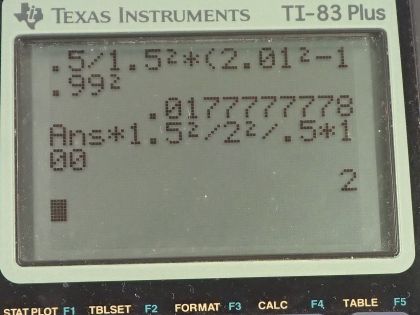Question
By how much leeway (both percentage and mass) would you have in the selection of the mass of the object in the previous problem if you did not wish the new period to be greater than 2.01 s or less than 1.99 s?
Final Answer
Solution video
OpenStax College Physics for AP® Courses, Chapter 16, Problem 16 (Problems & Exercises)

vote with a rating of
votes with an average rating of
.
Calculator Screenshots
Video Transcript
This is College Physics Answers with Shaun Dychko. A spring oscillates with a frequency of 1.50 seconds when it has a mass of 0.500 kilograms suspended from it and we'll put a subscript one for each of these pieces of information so this is the period one with mass one. And then we are told that we want a period two of 2.00 seconds and we don't know what that mass will be and we are asked what amount of tolerance do we have in choosing this second mass? The upper period that's tolerable is 2.01 seconds and the lower period that's tolerable is 1.99 seconds. and so how many kilograms difference is there in mass that would have this period versus this one and so that's the amount of kilograms tolerance and then take that as a percentage of mass two whatever that is and that will be the percentage tolerance. Okay! So we have to figure out first of all what the spring constant is so for period one we have it equal to 2π times square root m 1 over k and we know all the things in here except for k so let's use this to solve for the spring constant. We'll square both sides and then that gives us T 1 squared equals 4π squared m 1 over k and then multiply both sides by k over T 1 squared and then we have the spring constant is 4π squared m 1 over T 1 squared. And then we are going to figure out what is the mass in the upper period—the 2.01 second period. So the upper period is 2π times square root of the upper mass divided by the spring constant and we know everything here except for the upper mass because we found the spring constant already before and so we are gonna solve for m u and we'll square both sides and we get T upper squared equals 4π squared m u over k and then we'll solve for m u by multiplying both sides by k over 4π squared. and then switch the sides around. So we have m u equals k times T u squared over 4π squared. Now k is 4π squared m 1 over T 1 squared so we can substitute that in for k here and that's what I'm writing here 4π squared m 1 over T 1 squared multiplied by T u squared over 4π squared. The 4π squared's cancel and we are left with T u squared over T 1 squared times m 1 is m u. And by the same logic, we can find the lower mass by substituting in the period of the lower mass instead of a period of the upper mass here that has to be squared divided by T 1 squared times m 1. So the tolerance in our mass selection or the difference in mass between the upper and the lower possible masses is going to be T u squared over T 1 squared times m 1— that's what m u is— minus m L written as T L squared over T 1 squared times m 1. Then we can factor out the m 1 and the over T 1 squared from both these terms. So that's m 1 over T 1 squared times (T u squared minus T L squared). So we can plug in numbers now: we have 0.500 kilograms—mass m 1— divided by 1.50 seconds for period one squared times the upper period of 2.01 seconds squared minus the lower period of 1.99 seconds squared and that's 0.0178 kilograms is the difference in mass between the upper and the lower possible masses. Now the percentage leeway is gonna be this difference in mass divided by m 2 times 100 percent. Now m 2 using the same pattern we found here you know, we have mass of some scenario equals the period of that same scenario squared over T 1 squared times m 1 and so we have m 2 then is T 2 squared over T 1 squared times m 1. So dividing by m 2 is the same as multiplying by the reciprocal of this fraction so that's why I'm multiplying by T 1 squared over T 2 squared times m 1 and we plug in numbers. So we have 0.01777 kilograms—Δm— times 1.50 seconds squared divided by 2.00 seconds squared times 0.500 kilograms times 100 percent and this works out to 2.0 percent is the percent leeway in choosing this mass m 2 given this tolerance of periods between 1.99 seconds and 2.01 seconds.
